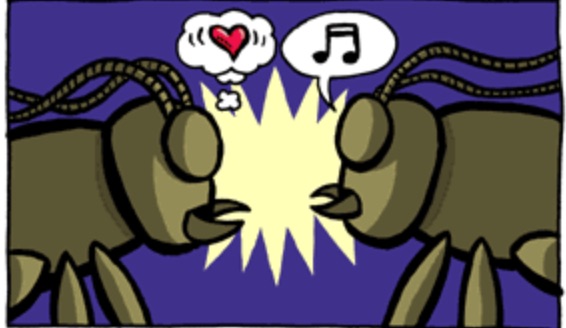I’m writing this blog from NCSE HQ and, dear readers, there is something in the air here other than awesome ideas. My histamines are in overload. My eyes are watering, my head is a cotton ball, and my nose is a faucet. As a result, I am feeling punchy, too. I offer this sad tale of my unprepared Bostonian immune system as background to  help explain my choice for this installment of "In the Classroom": an absolutely hysterical resource from the folks at Understanding Evolution called “Survival of the Sneakiest.”
help explain my choice for this installment of "In the Classroom": an absolutely hysterical resource from the folks at Understanding Evolution called “Survival of the Sneakiest.”
It’s a simple resource—no bells and whistles, no animation. It’s just a cartoon—a cartoon that addresses some of the fundamental misconceptions in evolution. What does “survival of the fittest” mean? Is there only one way to be “fit”? If you’re fit, will you always be fit? It’s all in there. And it’s hilarious. As evidence, I offer my favorite line: “Oh yeah! My exoskeleton is sooo glossy!” Need I say more?
I can see this being useful in a number of ways. The simplest is to let your students read it, laugh, and answer the questions provided at the end (or ones you make up). Slightly more complex is to have your students use it as inspiration to write their own cartoons that help unravel other misconceptions. (To ensure that you reward the content and not artistic ability, I’d suggest a grading rubric that focuses only on the  text.) Another option is to have your students read the “Evo in the News” article that inspired the cartoon. It’s a fascinating case study in evolution, which the folks at UCMP have been diligently updating as new data comes in. The article concludes with a number of challenging discussion and extension questions that get into the genetics of the traits involved. The most involved option would be having your students read the primary literature underlying the article and the cartoon; a list of the articles along with links is provided at the end of the “Evo in the News” article.
text.) Another option is to have your students read the “Evo in the News” article that inspired the cartoon. It’s a fascinating case study in evolution, which the folks at UCMP have been diligently updating as new data comes in. The article concludes with a number of challenging discussion and extension questions that get into the genetics of the traits involved. The most involved option would be having your students read the primary literature underlying the article and the cartoon; a list of the articles along with links is provided at the end of the “Evo in the News” article.
If you feel sheepish about including a cartoon in your curriculum, I hasten to assure you that the resource is aligned to the NGSS. And yes, it’s silly and it’s anthropomorphic, but it all works in this context. I don’t think there is any worry that students will think crickets actually serenade each other with the lyrics “Oh girl, you make my antennae tremble!”—but just in case, there is a note at the end that clarifies, “Crickets don’t actually sing with voices.” Now that’s covering your bases!
So what do you think? Would your students get a kick out of this? Does it have a place in your lesson plans? Let me know in the comments!
Are you a teacher and want to tell us about an amazing free resource? Do you have an idea for a future Misconception Monday or other post? Seen some good or bad examples of science communication lately? Drop me an email or shoot me a tweet <at>keeps3.

